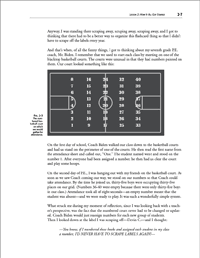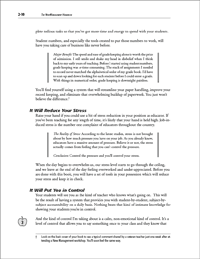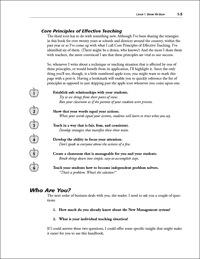

![]()
Goals for this lesson:
-
Realize that most new teachers struggle in the area of student management.
-
Begin to see the power of using student numbers.
-
Be able to verbalize the teacher benefits of the number system.
-
Be able to verbalize the student benefits of the number system.
-
Accept the fact that student numbers are just a tool.
Sample Pages
Just click on a page image to see the page in PDF format.


Apple margin icons
Numbered apples appear in the margins on certain pages. These reference the six Core Principles I developed during the writing of my fourth book, Eight Great Ideas. You can click on the page image below to read about these principles.

![]()
FAQ Lesson 2
I'm a new teacher. What do I do when veteran teachers at my school question the wisdom of the student number system?
For the most part, I've found that teachers are an incredibly supportive group. For anyone who does have concerns, hand him this book with the invitation to read the first few chapters. If they're really interested in discussing the advantages and disadvantages of using student numbers, they'll read the pages and then get back to you. If they're still not convinced, that's okay. Everyone is entitled to his own opinion.
If, however, they decline your offer to read the lessons you suggested, it would appear that they are more interested in passing judgement than they are in gaining insight into something that is unfamiliar to them. There's not much you're going to be able to do in this situation except make the best of it. One month with student numbers should convince you, though, that you've made the correct decision.
What do I do with the parent who just doesn't like the student number system?
Let me reassure you that, based upon my somewhat extensive experience at using student numbers, it's the rare parent who complains. Most of them love how organized the classroom is and how involved their children are.
If someone does object, schedule an appointment and listen to their concerns. Many times, that's all people need: an opportunity to share their feelings so that their input seems valuable.
During your discussion, make an effort to portray the student number system as an almost invisible part of your classroom structure. If it helps, call the numbers "desk numbers," "book numbers," "cubbie numbers," or any other designation that will emphasize the fact that student numbers were never designed to take the place of students' names.
No matter how you handle it, try to leave the impression that you appreciate their insight. Let them know that they are welcome to share their concerns whenever they wish. Your willingness to listen will sometimes speak louder than anything you end up saying during your conference.
